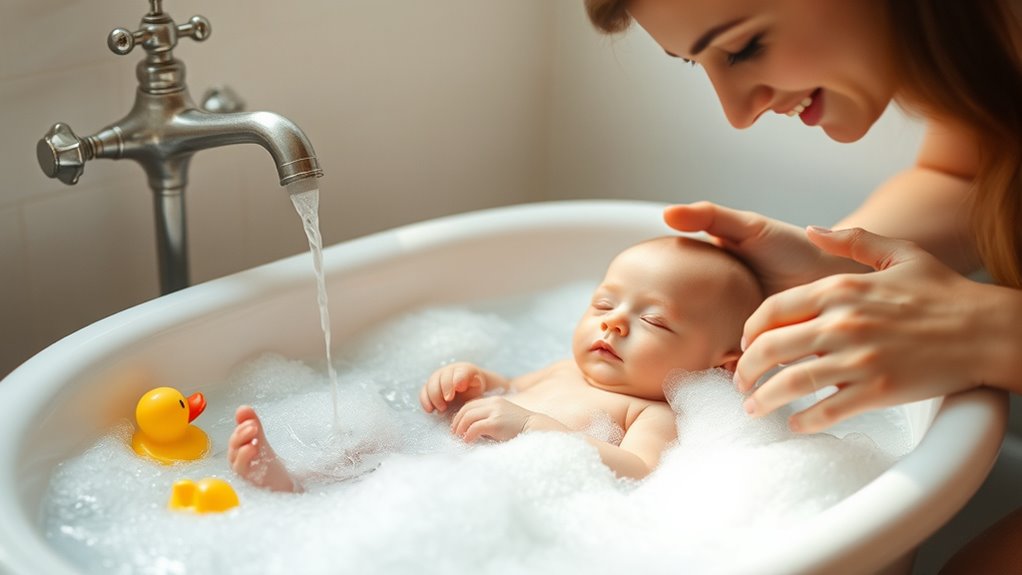When it’s time for your baby’s first bath, wait at least 24 hours after birth to allow for bonding and breastfeeding. Remember, newborns only need 1 to 3 baths a week, so a sponge bath until the umbilical cord stump falls off is sufficient. Always supervise your baby, make sure the water’s safe temperature, and keep all supplies close. After the bath, wrap your baby in a warm towel to keep them cozy. You’ll find more essential tips ahead.
Key Takeaways
- Wait at least 24 hours after birth for the first bath to promote bonding and breastfeeding.
- Use a sponge bath method initially until the umbilical cord stump falls off.
- Ensure water temperature is safe, ideally between 98.6°F to 100°F, for baby’s comfort.
- Gather all bathing supplies within reach to maintain focus and safety during the bath.
- Wrap baby in a warm towel immediately after the bath to keep them comfortable and dry.
Timing for Baby’s First Bath
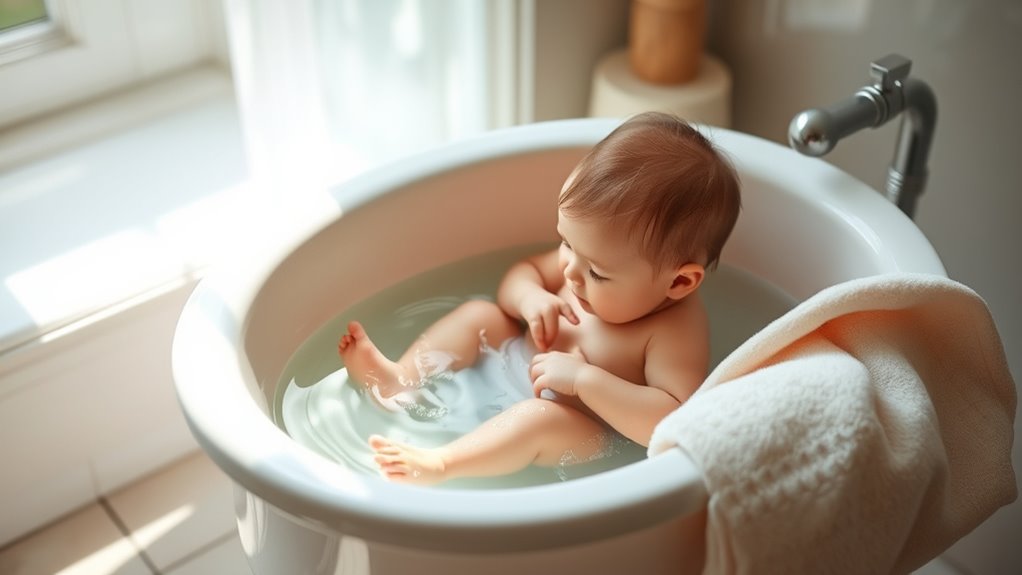
When it comes to timing your baby’s first bath, it’s best to wait at least 24 hours after birth.
The World Health Organization recommends delaying baby’s first bath to promote bonding and breastfeeding success. Early bathing can expose your newborn to risks like hypothermia and hypoglycemia.
Instead, focus on skin-to-skin care and initial breastfeeding during those vital first hours. Keeping the vernix caseosa, your baby’s protective coating, intact is essential as it helps maintain skin moisture and offers antibacterial properties.
If there’s a concern about exposure to pathogens like HSV, HIV, or hepatitis, a newborn sponge bath may be necessary after breastfeeding.
Prioritizing these first moments will enhance your baby’s well-being and strengthen your connection.
Bathing Frequency for Newborns
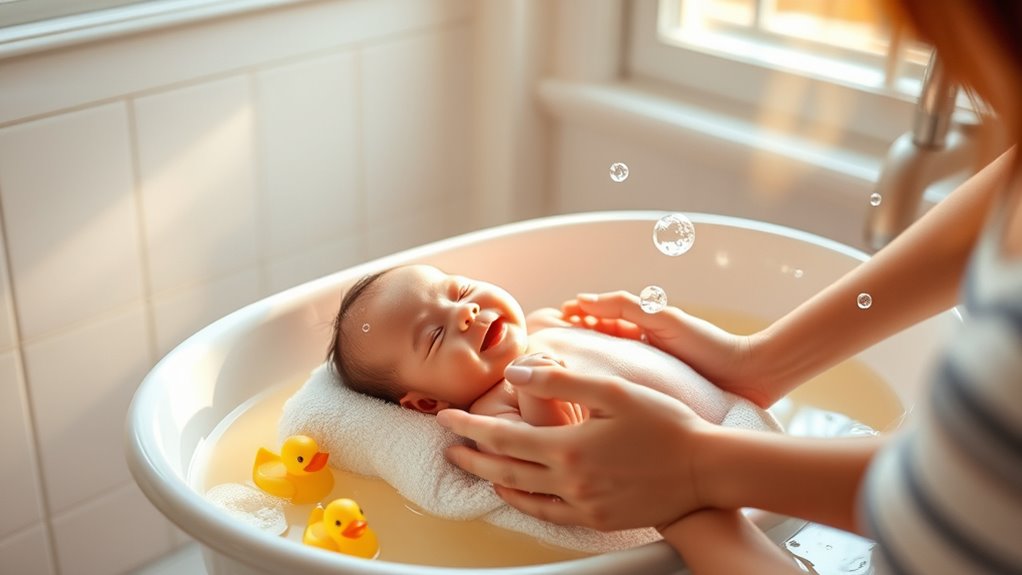
Newborns typically need just 1 to 3 baths per week during their first year to keep their delicate skin from drying out. Daily baths aren’t necessary since your baby won’t accumulate much dirt or sweat.
Until the umbilical cord stump falls off, sponge baths are recommended to keep your newborn clean without over-drying their skin. Many families choose to wait several days after birth for that first bath, allowing for better bonding and breastfeeding success. It’s crucial to use a newborn bath tub that prioritizes safety and comfort during bath time. Incorporating sustainable fashion practices into your baby care routine, such as using eco-friendly bath products, can also be beneficial for your newborn’s sensitive skin.
It’s important to maintain hygiene by regularly cleaning the diaper area and skin creases between baths. Incorporating bath time into a calming routine can soothe your baby and promote better sleep, making it a cherished part of your daily schedule. Additionally, creating a safe and comfortable living space for seniors can enhance the overall experience of caring for a newborn and ensure peace of mind for parents.
How to Give a Sponge Bath

Once your baby is ready for their first bath, sponge bathing is a gentle and effective way to keep them clean while protecting their delicate skin.
Start by laying your baby on a comfortable, flat surface, keeping them warm with a towel. Use a basin or sink filled with warm water and a damp washcloth to bathe them. It’s important to ensure that the water temperature is comfortable for infants to prevent any discomfort during the bath.
Lay your baby on a flat surface, keeping them warm with a towel, and prepare a basin of warm water and a washcloth for bathing.
Begin with the face, gently wiping around the eyes and mouth, then move to the neck, arms, and legs, paying special attention to skin folds and the diaper area. It’s important to always use mild soap to avoid irritating their sensitive skin.
Use mild soap sparingly for heavily soiled spots, rinsing off with clean, warm water afterward.
Always keep one hand on your baby during the sponge bath to guarantee their safety. Additionally, ensure that the bathing environment is calm and creates a soothing atmosphere to help your baby feel secure during the process.
Safety Tips for Regular Baths
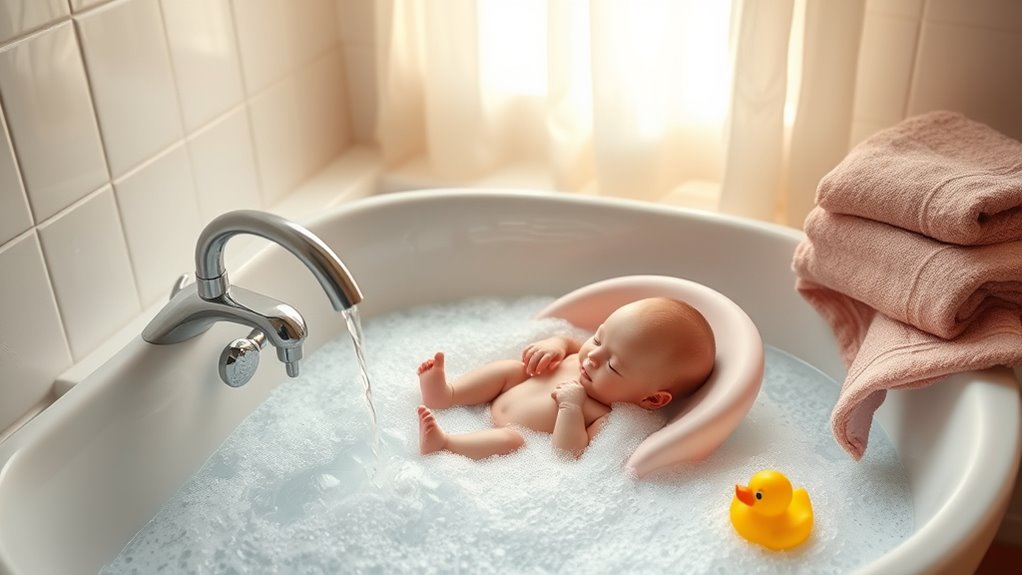
Bath time can be a fun and bonding experience, but safety must always come first.
Always maintain touch supervision during your baby bath; never leave your little one unattended in or near the water.
Ascertain the water temperature is safe and comfortable, ideally between 98.6°F to 100°F. Test it with your wrist or elbow before placing your baby in the tub. Consider using a heat pump system to maintain a comfortable room temperature during bath time, as this can enhance overall energy efficiency in your home.
Use a safe infant tub with a sloped, textured surface for stability.
Gather all necessary supplies within arm’s reach to minimize distractions.
Keep one hand on your baby at all times to prevent slipping and ascertain their safety throughout the bathing process. Regular cleaning of air purifiers can also help maintain a healthy environment for your baby by reducing airborne pollutants.
Post-Bath Skin Care and Comfort
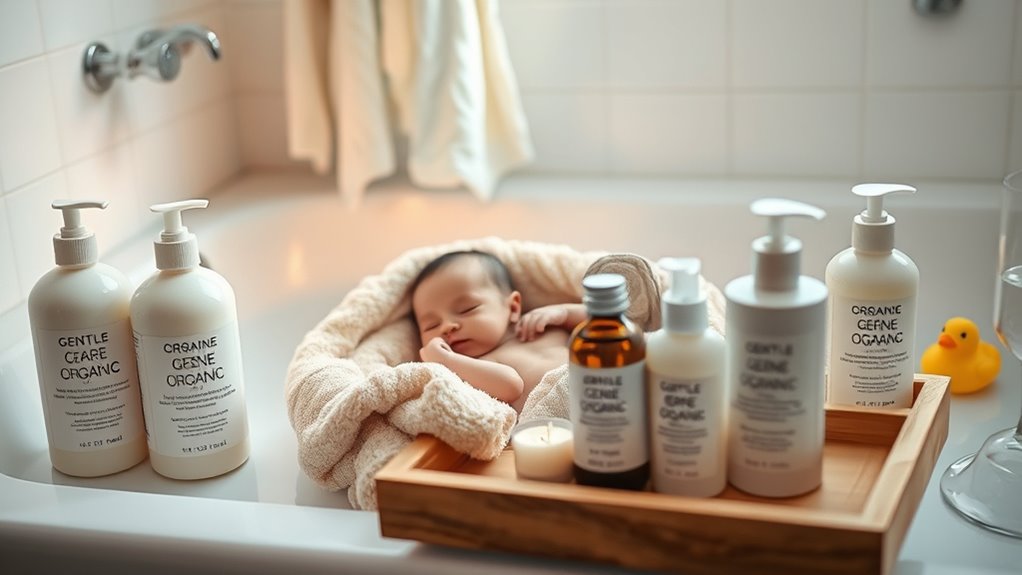
After your baby’s bath, wrapping them in a warm towel is essential for comfort and to prevent heat loss. Newborns can get cold quickly, so act fast! You don’t need to apply lotion after every bath, as their skin is naturally soft. Use hypoallergenic lotion only if recommended. When applying, warm it in your hands first to avoid tears. Avoid baby powders due to respiratory risks; keeping the skin dry is better. Gently pat your baby dry, focusing on skin folds to prevent moisture buildup, which can lead to irritation. Additionally, maintaining healthy skin care practices can support your baby’s overall comfort and well-being.
| Step | Action | Tips |
|---|---|---|
| Wrap | Use a warm towel | Prevents heat loss |
| Dry | Pat gently | Focus on skin folds |
| Lotion | Optional, if needed | Use hypoallergenic options |
| Baby Powder | Avoid | Risk of respiratory issues |
| Moisture Care | Check for buildup | Prevent irritation |
Frequently Asked Questions
What Is the Ritual of Baby First Bath?
The ritual of a baby’s first bath can be a special and memorable experience.
You’ll want to prepare a warm, safe space with all essentials within reach.
As you gently wash your baby, focus on maintaining a calm environment to enhance bonding.
Remember to wait until the umbilical cord stump has healed, and aim for a relaxed approach.
Enjoy this precious time together, making it a loving and enjoyable moment for both of you.
Do You Have to Wait Until the Umbilical Cord Falls off to Bathe?
Did you know that around 90% of newborns lose their umbilical cord stump within the first three weeks?
You should definitely wait until it falls off before giving your baby a full bath to prevent infection and irritation.
During this time, sponge baths are a great alternative, keeping the stump dry and clean.
Once it’s healed, you can safely shift to full immersion baths without any worries.
How Do I Give My Baby a Bath for the First Time?
When you give your baby a bath for the first time, start by gathering all supplies—towels, washcloth, and mild soap—within reach.
Make sure the water temperature‘s between 90-100°F, testing it with your wrist or elbow.
Keep one hand on your baby at all times to prevent slipping.
Focus on sponge bathing until the umbilical cord stump falls off, cleaning their face and creases while keeping them warm and comfortable.
How Long Should a Baby Take a Bath for the First Time?
So, you’re thinking of giving your tiny human a bath for the first time? Don’t worry; it’s not like you’re trying to wash a greased pig!
Aim for about 5 to 10 minutes—just enough time to keep your little one comfy without turning them into a prune. As they get used to the splashing, you can gradually extend that time.
Conclusion
When it comes to your baby’s first bath, a little preparation goes a long way. By timing it right and following our tips, you’ll create a soothing, safe, and satisfying experience for both you and your little one. Remember, consistency is key to keeping your newborn clean and comfortable. So, embrace the bonding experience, and let those bath-time bubbles bring joy to your journey of parenthood. Happy bathing!
